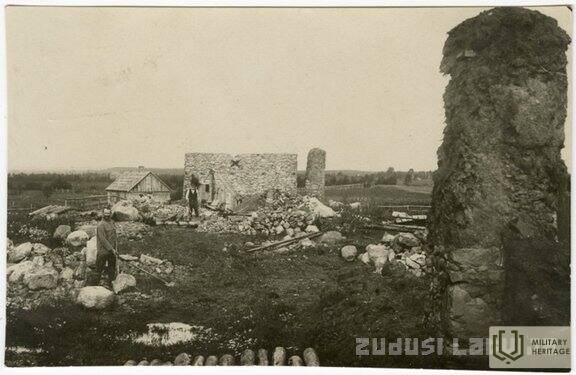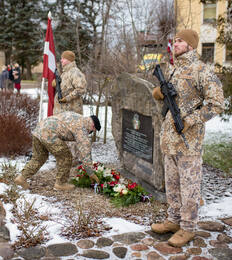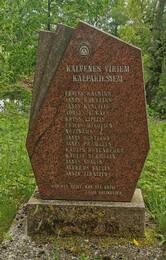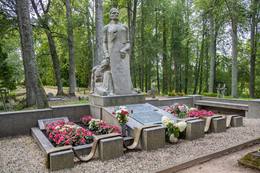Skrundos mūšis I WW1, I Nepriklausomybės karai
Latvijos nacionalinės gvardijos pradėtas puolimas, įvykęs 1919 m. sausio 29 d., buvo nukreiptas į Skrundos miesto užėmimą.
Mūšyje dalyvavo Latvijos nepriklausomojo bataliono instruktorių kuopa ir Cėsių kuopa, be Rusijos kuopos ir vienos vokiečių pėstininkų bataliono kuopos. Puolimui padėjo pusė vokiečių artilerijos baterijos.
Skrundos dvaro apylinkėse buvo 2-ojo sovietų latvių šaulių pulko 1-asis batalionas. Puolimas prasidėjo 4 val. ryto, o 11 val. ryto priešas pradėjo trauktis iš Skrundos bažnyčios ir Skrundos dvaro.
Skrundos mūšis buvo pirmasis sėkmingas Laikinosios vyriausybės ginkluotųjų pajėgų puolimas Nepriklausomybės kare.
Daugiau informacijos šaltinių
Prarasta Latvija – Latvijos nepriklausomybės kovų laukas prie Skrundos dvaro (zudusilatvija.lv)
Susijusi laiko juosta
Susijusios vietos
Skrundos mūšio memorialas ir vėliavos diena
Skrundos mūšio memorialas yra Skrundos centre, Oskaro Kalpakos parke netoli Skrundos kultūros namų, Kuldygos ir Liepojos gatvių sankryžoje. 2005 m. prie memorialo buvo pastatytas akmuo, skirtas 1919 m. sausio 29 d. mūšiui atminti, kai Oskaro Kalpako vadovaujamas batalionas kartu su vokiečių ir rusų Landesvero daliniais išvadavo Skrundą nuo bolševikų. Vėliavos dienos tradicija tęsiama nuo 2004 m., minint pirmąjį iš bolševikų išlaisvintą miestą ir jo išvaduotojus, kurie 1919 m. sausio 29 d. Skrundos bažnyčioje iškėlė Latvijos vėliavą.
Pirmaisiais Nepriklausomybės karo mėnesiais Latvijos laikinoji vyriausybė, spaudžiama bolševikų, sparčiai prarado teritoriją. 1919 m. sausio 22 d. bolševikai užėmė Skrundą. Po savaitės, sausio 29 d., ankstyvą rytą, prasidėjo puolimas Skrundai atsiimti. Latvijos atskirasis batalionas, vadovaujamas pulkininko leitenanto Oskaro Kalpako, turėjo pulti Rudbāržu-Skrundos plentu ir išstumti bolševikus iš Skrundos. Po to turėjo vykti vokiečių dalinių flanginis puolimas, kurio užduotis buvo sunaikinti artėjantį priešą, o rusų kuopa turėjo pulti tarp Latvijos ir Vokietijos dalinių, orientyru naudodama Skrundos bažnyčią. Puolimą taip pat rėmė vokiečių artilerijos baterija. Puolimo dieną buvo 15 laipsnių šalčio, švietė ryški saulė, kalpakai turėjo kirsti giedrą lauką, o bolševikai slėpėsi dvaro akmeniniuose pastatuose. Bolševikai atidengė ugnį, kai užpuolikų grandinė buvo nutolusi apie 300 metrų, kilo abipusis susišaudymas, ir Oskaro Kalpako vadovaujami kareiviai sparčiai puolė į priekį, priversdami priešą nutraukti ugnį ir trauktis per Ventą. Po maždaug 3 valandų kovos Skrunda buvo užimta apie 9 val. ryto, Latvijos atskirajame batalione buvo sužeisti tik 2 kariai.
Skrundos mūšis turėjo didelę reikšmę Latvijos laikinosios vyriausybės ginkluotų Speko karių moralei, nes tai iš tikrųjų buvo pirmoji reikšminga pergalė mūšiuose prieš bolševikus. Be to, pats vadas Oskaras Kalpakas mūšyje demonstravo ypatingą drąsą, savo pavyzdžiu skatindamas karius nebijoti.
Paminklas ir atminimo ženklai O. Kalpakos bataliono kariams Aizporės kapinėse
Maždaug pusiaukelėje tarp Rudbāržių ir Kalvės, seno kelio, lygiagretaus greitkeliui A9, pakraštyje yra Aizporės kapinės.
Aplinkiniuose namuose gyvenusiems Oskaro Kalpakos bataliono savanoriams kariams pastatytas paminklas ir 12 atminimo ženklų.
Kalvenės savivaldybės Aizporės pusdvaris buvo tolimiausia vieta, į kurią 1919 m. sausio 22 d. atsitraukė Latvijos atskirasis (Kalpakų) batalionas. Čia batalionas gavo pirmąjį pastiprinimą iš Liepojos – 35 vyrus ir pradėjo kontrpuolimą, sausio 24 d. pasiekdamas Rudbāržius.
Paminklo pastatymo idėja kilo dar 1920-aisiais, kai buvę 1-ojo Latvijos atskirojo bataliono, arba Kalpakos bataliono, kariai pastatė laikiną atminimo ženklą – ąžuolo luitą su lenta. Tuo metu gimė idėja sukurti didesnį memorialinį ansamblį, tačiau ji buvo įgyvendinta tik 1993 m. gegužės 15 d., kai buvo atidengtas atminimo ženklas – Šviesos spindulys – obeliskas iš pilko granito.
2,3 m aukščio atminimo ženklą sukūrė skulptoriai Harijs SPRINCIS ir Imants LUKAŽIS (1930–2007 m., palaidotas Aizpuri kapinėse), kurio tėvas taip pat buvo O. Kalpakos bataliono karys. Atminimo ženkle iškalti poeto E. VIRZOS vardai:
KALPAKAM
IR JO
KARIEMS
1919 m.
Sausio 25 d. rytas
NUO ŠIOS DIENOS
TAIP PAT IŠ
UGNIS
VIRŠ LATVIJOS
Tuo pačiu metu 12 kapinėse palaidotų Kalpų kapai buvo pažymėti ąžuolinėmis atminimo lentomis, kurios 2019 m. pakeistos granito žymekliais.
Dešimtojo dešimtmečio pradžioje kapinėse buvo pastatytas dviejų metrų aukščio paminklas, šalia kurio auga legendinio aktoriaus Ēvaldo Valterio dešimtojo dešimtmečio viduryje pasodintas ąžuolas.
Pulkininko Oskaro Kalpako amžinojo poilsio vieta
Įsikūręs Visagalos kapinėse, Madonos apskrityje
Eksponuojamas Oskaro Kalpako paminklas, atidengtas 1927 m. liepos 10 d., Kārlio Zālės ir Arnoldio Dzirkalio – trijų figūrų kompozicija, kurios centre pavaizduotas senovės latvių karys su skydu ir kardu rankose, o abiejose jo pusėse stovi du kariai. Skulptūrinės grupės papėdėje ant granito pagrindo įstrižai pritvirtinta bronzinė lentelė, kurioje išgraviruotas tekstas, kuriame yra ir Edvardo Virzos eilėraštis, skirtas Kalpakui.
Oskaras Kalpakas žuvo 1919 m. kovo 6 d. netoli „Airītē“, Skrundos–Saldus kelio pakraštyje, o jo palaikai rugsėjo 18 d. iš Liepojos šiaurinių kapinių buvo perkelti į šeimos kapines Visagaloje.
Paminklą atidengė pulkininko O. Kalpako paminklo komiteto pirmininkas generolas J. Balodis, dalyvaujant tuometiniam Respublikos prezidentui G. Zemgalui, ministrui pirmininkui M. Skujeniekui, Saeimos pirmininkui P. Kalniniui, karo ministrui R. Bangerskiui ir K. Ulmaniui. Paminklo kertinis akmuo buvo padėtas 1925 m. birželio 19 d. Paminklo akmuo buvo paimtas iš pulkininko gimtųjų namų Sienos pelkėje, ant šio akmens O. Kalpakas vaikystėje mėgo groti smuiku.
Oskaro Kalpako muziejus ir memorialinė vieta „Airītes“
Oskaro Kalpako muziejus ir memorialinė vieta „Airītes“ yra tarp Saldaus ir Skrundos, netoli greitkelio A9. Parodoje pateikiama išsami informacija apie pulkininką Oskarą Kalpaką ir jo batalioną, taip pat pristatoma Latvijos nacionalinės armijos ir memorialinės vietos „Airītes“ istorija. Parodoje pulkininką Oskarą Kalpaką pristatoma kaip asmenybę, kaip karį ir kaip kovotoją už Latvijos nepriklausomybę. Parodoje taip pat yra garso įrašų latvių, anglų ir vokiečių kalbomis. Juose pabrėžiama 1918/1919 m. istorinių įvykių svarba saugant Latvijos valstybingumą. Muziejaus pastatas yra restauruotas.
Įėjimas nemokamas; ekskursija su gidu – mokama. Komplekse yra poilsio zona, parkas, kliūčių ruožas, galima lankyti įvairius užsiėmimus, yra seminarų salė iki 30 žmonių.
Susijusi istorija
Aizporių dvaras Nepriklausomybės kovų metu
Aizporų pusdvaras, Aizputės rajonas, Kalvenės savivaldybė, yra vakariausia Latvijos vieta, į kurią atsitraukė pulkininko Oskaro Kalpako atskirasis batalionas.
Pusiaukelėje tarp Rudbāržių ir Kalvenės, pakelėje, yra Aizporės kapinės. Jose stovi paminklas ir 12 atminimo ženklų Oskaro Kalpakos bataliono savanoriams kariams.










